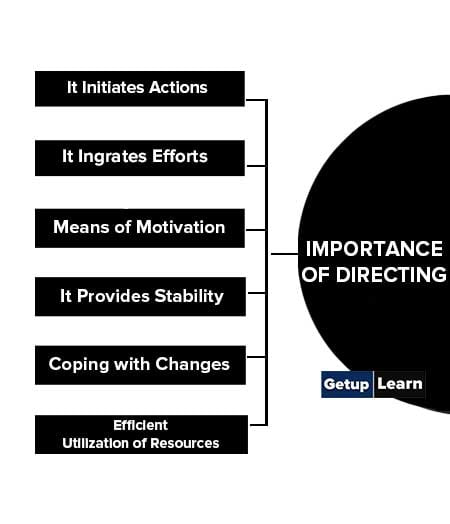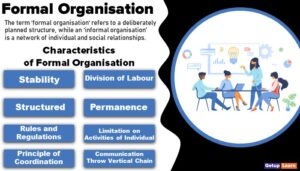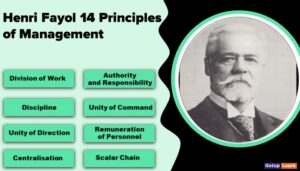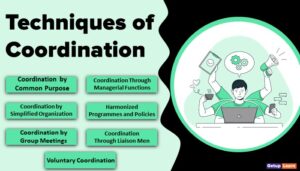Table of Contents
What is Directing?
Directing means giving instructions and guiding people in doing work. directing refers to the process of instructing, guiding, counseling, motivating, and leading people in the organization to achieve its objectives.
Directing is a managerial process that takes place throughout the life of an organization.

A decision is an act of selection or choice of one action from several alternatives. Decision- making can be defined as the process of selecting a right and effective course of action from two or more alternatives for the purpose of achieving the desired result. Decision-making is the essence of management.
Decision-making is the selection of one course of action from two or more alternative courses of action. It is a choice-making activity and the choice determines our action or inaction.
Definition of Directing
These are the following definitions of directing by authors:
[su_quote cite=”Koontz and O’Donnell”]Direction is the executive function of guiding and observing subordinates.[/su_quote]
[su_quote cite=”Earnest Dale”]Direction is telling people what to do and seeing that they do it to the best of their ability. It includes making assignment, explaining procedures, seeing that mistakes are corrected, providing on the job instructions and of course, issuing orders.[/su_quote]
[su_quote cite=”Getuplearn”]Directing can be defined as that function of management, which helps in guiding and leading people to work in such a manner as to perform efficiently and effectively for the attainment of organizational objectives.[/su_quote]
Features of Directing
These are some features of directing explain below:
- Directing Initiates Action
- Directing at Level of Management
- Creative Activity
- Executive Function
- Directing is a Continuous Process
- Directing Flows from Top to Bottom
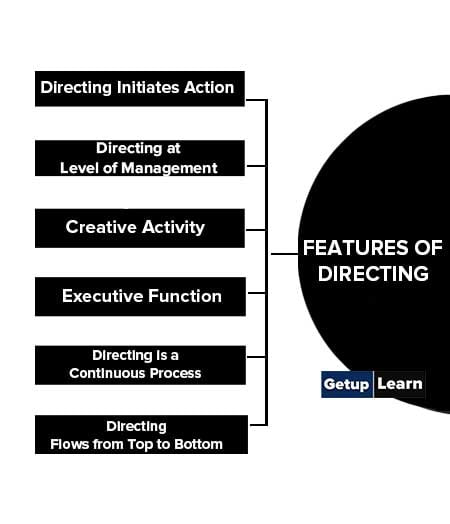
Directing Initiates Action
Directing is a key managerial function. A manager has to perform this function along with planning, organizing, staffing, and controlling while discharging his duties in the organization. While other functions prepare a setting for action, directing initiates action in the organization.
Directing at Level of Management
Directing Takes Place at Every Level of Management: Every manager, from the top executive to the supervisor performs the function of directing. The directing takes place wherever superior-subordinate relations exist.
Creative Activity
The direction function helps in converting plans into performance. Without this function, people become inactive and physical resources are meaningless.
Executive Function
The direction function is carried out by all managers and executives at all levels throughout the working of an enterprise, a subordinate receives instructions from his superior only.
Directing is a Continuous Process
Directing is a continuous activity. It takes place throughout the life of the organization irrespective of people occupying managerial positions.
We can observe that in organizations like Infosys, Tata, BHEL, HLL and the managers may change but the directing process continues because without direction the organizational activities cannot continue further.
Directing Flows from Top to Bottom
Directing is first initiated at the top level and flows to the bottom through the organizational hierarchy. It means that every manager can direct his immediate subordinate and take instructions from his immediate boss.
Importance of Directing
These are the importance of directing given below:
- It Initiates Actions
- It Ingrates Efforts
- Means of Motivation
- It Provides Stability
- Coping with Changes
- Efficient Utilization of Resources
It Initiates Actions
Directions are the function that is the starting point of the work performance of subordinates. It is from this function the action takes place, subordinates understand their jobs and do according to the instructions laid.
Whatever our plans are laid, out can be implemented only once the actual work starts. It is there that direction becomes beneficial.
It Ingrates Efforts
Through direction, the superiors are able to guide, inspire and instruct the subordinates to work. For this, efforts of every individual towards the accomplishment of goals are required. It is through this direction the efforts of every department can be related and integrated with others.
This can be done through persuasive leadership and effective communication. Integration of efforts brings effectiveness and stability to a concern.
Means of Motivation
The direction function helps in the achievement of goals. A manager makes use of the element of motivation here to improve the performances of subordinates.
This can be done by providing incentives or compensation, whether monetary or non-monetary, which serves as a “Morale booster” to the subordinates Motivation is also helpful for the subordinates to give the best of their abilities which ultimately helps in growth.
It Provides Stability
Stability and balance in concern become very important for long-term sun survival in the market. This can be brought upon by the managers with the help of four tools or elements of direction function a judicious blend of persuasive leadership, effective communication, strict supervision, and efficient motivation.
Stability is very important since that is an index of the growth of an enterprise. Therefore a manager can use all four traits in him so that performance standards can be maintained.
Coping with Changes
It is a human behavior that human beings show resistance to change. Adaptability to changing environment helps in sustaining planned growth and becoming a market leader. It is directing function which is of use to meet changes in the environment, both internal and external.
Effective communication helps in coping with the changes. It is the role of the manager here to communicate the nature and contents of changes very clearly to the subordinates. This helps in clarifications, easy adaptions, and smooth running of an enterprise.
Efficient Utilization of Resources
Direction finance helps in clarifying the role of every subordinate towards his work. The resources can be utilized properly only when less wastage, duplication of efforts, overlapping of performances, etc. doesn’t take place.
Through direction, the role of subordinates become clear as the manager makes use of his supervisory, guidance, instructions, and motivation skill to inspire the subordinates. This helps in the maximum possible utilization of resources of men, machines, materials, and money which helps in reducing costs and increasing profits.
Elements of Directing
Let’s understand the elements of directing in detail:
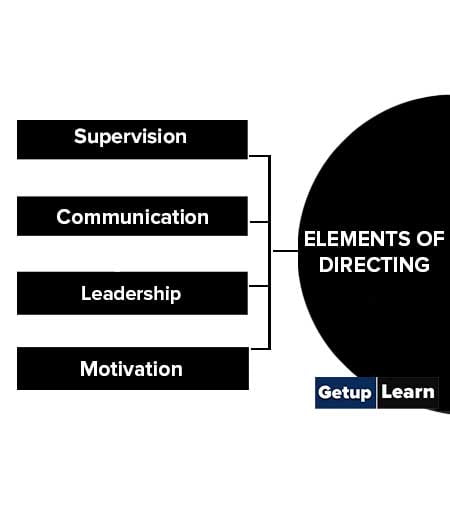
Supervision
It refers to monitoring the progress of routine work of one’s subordinates and guiding them properly. Supervision is an important element of the directing function of management.
Supervision has an important feature that face-to-face contact between the supervisor and his subordinate is a must. All employees working in an organization require supervision so that they are effective in their actions. Supervision means a manager overseeing ‘what is being done by his/her subordinates.
Communication
It refers to the art of transferring facts, ideas, feeling, etc. from one person to another and making him understand them. A manager has to continuously tell his subordinates about what to do, how to do it, and when to do various things.
Only through good communication can company policies and practices be formulated and administered. The success of all managerial functions depends on successful communication. Communication is a two-way channel.
Also, it is essential to know their reactions. To do all this it becomes essential to develop effective telecommunication facilities. Communication by developing mutual understanding inculcates a sense of cooperation which builds an environment of coordination in the organization.
Leadership
It refers to influencing others in a manner to do what the leader wants them to do. Leadership plays an important role in directing. Only through this quality, a manager can inculcate trust and zeal among his subordinates.
Leadership involves the way a manager behaves in his man-to-man relationship with his subordinates. In leading, a manager strives to integrate the needs of people with the welfare of his company or department.
Leadership is an interpersonal influence; exercised in the situation and directed, through the communication process toward the attainment of a specific goal or goals.
Motivation
It refers to that process that excites people to work for the attainment of the desired objective. Among the various factors of production, it is only the human factor that is dynamic and provides mobility to other physical resources.
If the human resource goes static then other resources automatically turn immobile. Thus, it becomes essential to motivate the human resource to keep them dynamic, aware, and eager to perform their duty. Both monetary and non-monetary incentives are given to the employees for motivation.
Principles of Directing
Let’s discuss the principles of directing:
- Maximum Individual Contribution
- Harmony of Objectives
- Unity of Command
- Appropriateness of Direction Technique
- Managerial Communication
- Use of Informal Organization
- Leadership
- Follow Through
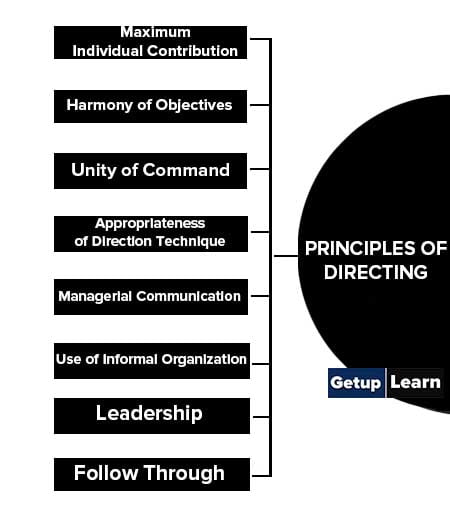
Maximum Individual Contribution
This principle emphasizes that directing techniques must help every individual in the organization contribute to his maximum potential for the achievement of organizational objectives. It should bring out the untapped energies of employees for the efficiency of the organization.
For example, a good motivation plan with suitable monetary and non-monetary rewards can motivate an employee to contribute his or her maximum efforts to the organization as he or she may feel that their efforts will bring them suitable rewards.
Harmony of Objectives
Very often, we find that the individual objectives of employees and the organizational objectives as understood are conflicting with each other.
For example, an employee may expect an attractive salary and monetary benefits to fulfill his personal needs. The organization may expect employees to improve productivity to achieve expected profits.
But, good directing should provide harmony by convincing that employee rewards and work efficiency are complementary to each other.
Unity of Command
This principle insists that a person in the organization should receive instructions from one superior only. If instructions are received from more than one, it creates confusion, conflict, and disorder in the organization. Adherence to this principle ensures effective direction.
Appropriateness of Direction Technique
According to this principle, appropriate motivational and leadership techniques should be used while directing the people based on subordinate needs, capabilities, attitudes, and other situational variables.
For example, for some people, money can act as a powerful motivator while for others promotion may act as an effective motivator.
Managerial Communication
Effective managerial communication across all the levels in the organization makes direction effective. Directing should convey clear instructions to create total understanding among subordinates.
Through proper feedback, managers should ensure that subordinate understands their instructions clearly.
Use of Informal Organization
A manager should realize that informal groups or organizations exist within every formal organization. He should spot and make use of such organizations for effective directing.
Leadership
While directing the subordinates, managers should exercise good leadership as it can influence the subordinates positively without causing dissatisfaction among them.
Follow Through
Mere giving an order is not sufficient. Managers should follow it up by reviewing continuously whether orders are being implemented accordingly or whether any problems are being encountered. If necessary, suitable modifications should be made in the directions.
What is the meaning of directing?
Directing can be defined as that function of management, which helps in guiding and leading people to work in such a manner as to perform efficiently and effectively for the attainment of organizational objectives.
What is the definition of directing?
Direction is telling people what to do and seeing that they do it to the best of their ability. It includes making assignments, explaining procedures, seeing that mistakes are corrected, providing on-the-job instructions, and of course, issuing orders. By Earnest Dale
What are the features of directing?
Following are the features of directing:
1. Directing Initiates Action
2. Directing at Level of Management
3. Creative Activity
4. Executive Function
5. Directing is a Continuous Process
6. Directing Flows from Top to Bottom.
What are the importance of directing?
Following are the importance of directing:
1. It Initiates Actions
2. It Ingrates Efforts
3. Means of Motivation
4. It Provides Stability
5. Coping with Changes
6. Efficient Utilization of Resources.
What are the elements of directing?
Following are the elements of directing:
1. Supervision
2. Communication
3. Leadership
4. Motivation.
What are the principles of directing?
Following are the principles of directing:
1. Maximum Individual Contribution
2. Harmony of Objectives
3. Unity of Command
4. Appropriateness of Direction Technique
5. Managerial Communication
6. Use of Informal Organization
6. Leadership
8. Follow Through.

